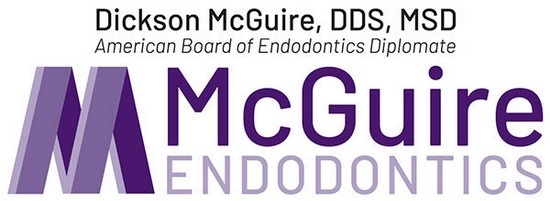Endodontic FAQ's
FREQUENTLY ASKED QUESTIONS
Endodontics is a branch of dentistry recognized by the American Dental Association involving the treatment of the pulp (root canal) and surrounding tissues of the tooth. When you look at your tooth in the mirror, what you see is the crown. The rest of the tooth, the portion hidden beneath the gum line, is called the root. Though the outer portion of the root is a hard tissue called dentin, the inside channel or "root canal" contains a pulp of soft tissue, blood vessels, and nerves. Bacteria that are introduced into the pulp as a result of tooth decay, periodontal disease, tooth fracture, or other problems, can severely damage the pulp. When that happens, an endodontic specialist removes the diseased pulp to save the tooth and prevent further infection and inflammation. After successful endodontic treatment, the tooth continues to perform normally.
No. While x-rays will be necessary during your endodontics treatment, we use an advanced non-film computerized system, called digital radiography, that produces radiation levels up to 90 percent lower than those of already low-dose conventional dental x-ray machinery. These digital images can be optimized, archived, printed, and sent to co-therapists via e-mail or diskette. For more information contact Soredex Technologies, Inc.
We adhere to the most rigorous standards of infection control advocated by OSHA, the Centers for Disease Control, and the American Dental Association. We utilize autoclave sterilization and barrier techniques to eliminate any risk of infection.
When your root canal therapy has been completed, a record of your treatment will be sent to your restorative dentist. You should contact his office for a follow-up restoration within a few weeks of completion at our office. Your restorative dentist will decide on what type of restoration is necessary to protect your tooth. It is rare for endodontic patients to experience complications after routine endodontic treatment or microsurgery. If a problem does occur, however, we are available at all times to respond.
The Best Technology
We have committed to adapting to biologically based procedural and conceptual changes as they occur. Several technologies have made a profound impact on the way modern endodontic treatment is performed. We have invested in and trained in the use of several of these technologies to achieve the highest clinical treatment standards.
Computerized Digital Radiography
Digital radiography has vastly increased the sophistication of diagnostic capabilities. Digital filmless x-ray imaging reduces the level of radiation exposure by up to 90% and reduces the waiting time for processing an image. Our office uses the smallest and most flexible sensor for your comfort.
Operating Microscopes (PRO ergo) with the Best Optics
The microscope provides commanding visual control with a precision that allows for new treatment possibilities which take advantage of the increased magnification and illumination.
Digital Microphotography
Digital images obtained through the microscope can be viewed by you on large video monitors in the operatories and enhance our ability to communicate and involve you in your treatment. The digital microphotographs become a part of your record and can be shared with your dentist’s office in a report.
Advanced Techniques
The latest and most predictable anesthesia, cleaning, shaping, and filling techniques are used to produce an optimal treatment outcome.
CBCT (3D Images)
3D images are extremely important for the diagnosis and treatment planning of each unique case. Converting from 2D to 3D radiographs has aided us in identifying the following:
- Measured working limits of each identifiable canal of the tooth, to ensure accuracy during treatment.
- Deep un-restorable cracks.
- Diagnosing periodontal disease.
- The exact size, location, and apex where the lesion is present.
- Diagnosing sinusitis, defined as inflammation in the maxillary sinus causing tooth sensitivity.
- Measuring bone density to ensure periodontal support.
In conclusion, this technology has allowed us to view and assess practical treatment diagnosis with greater results than just the 2D imaging alone.
